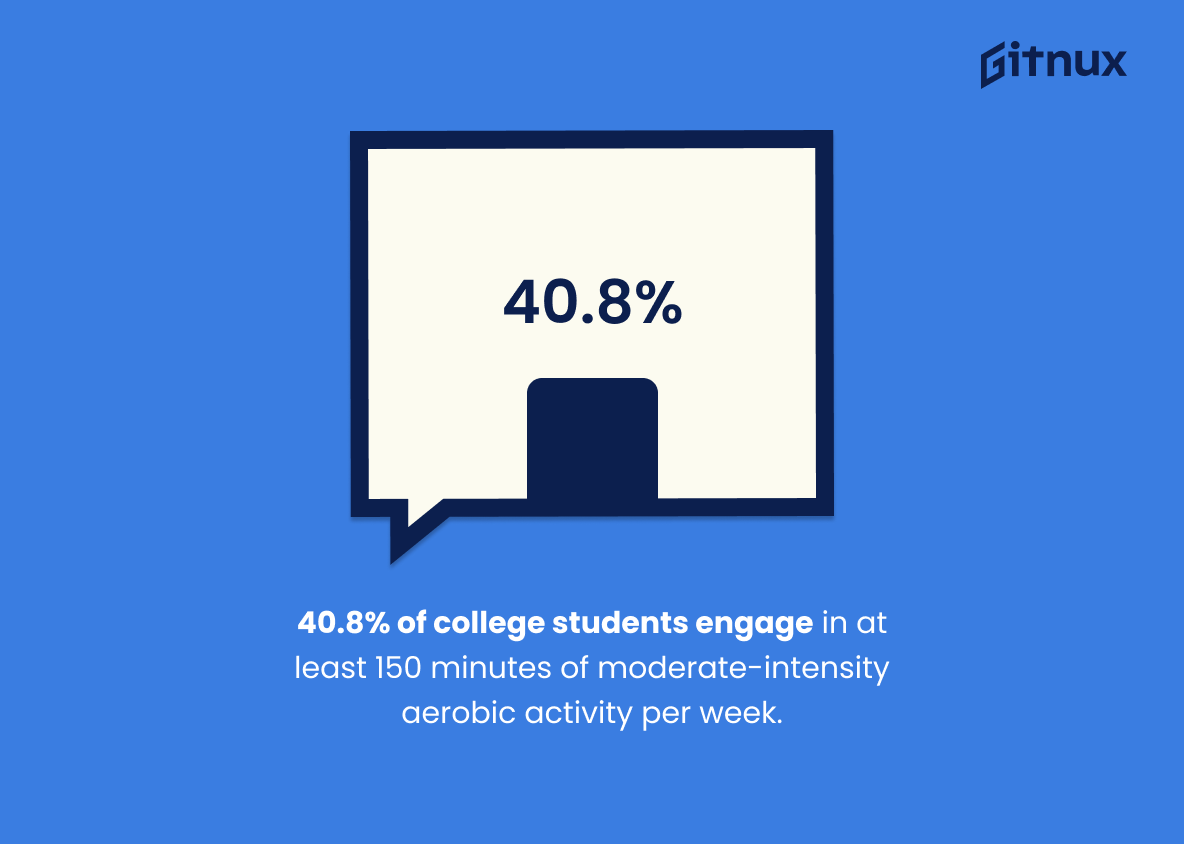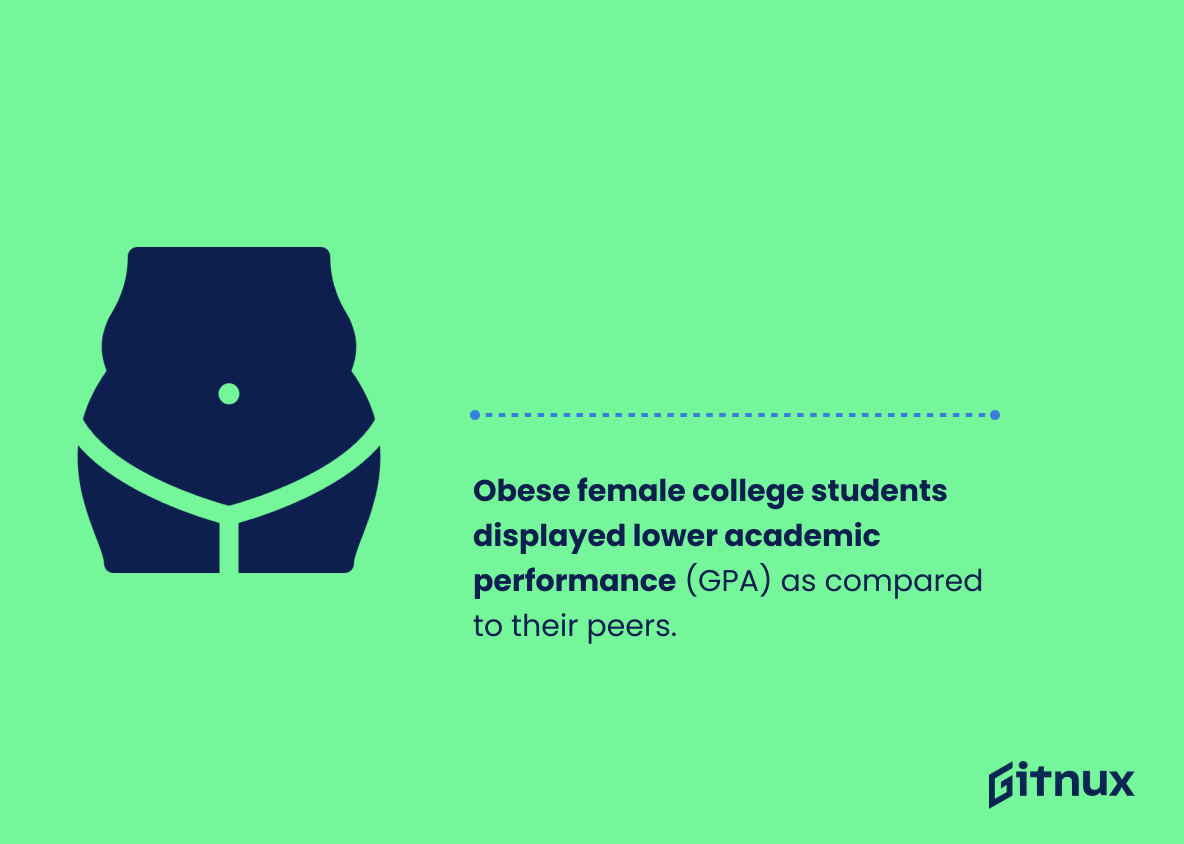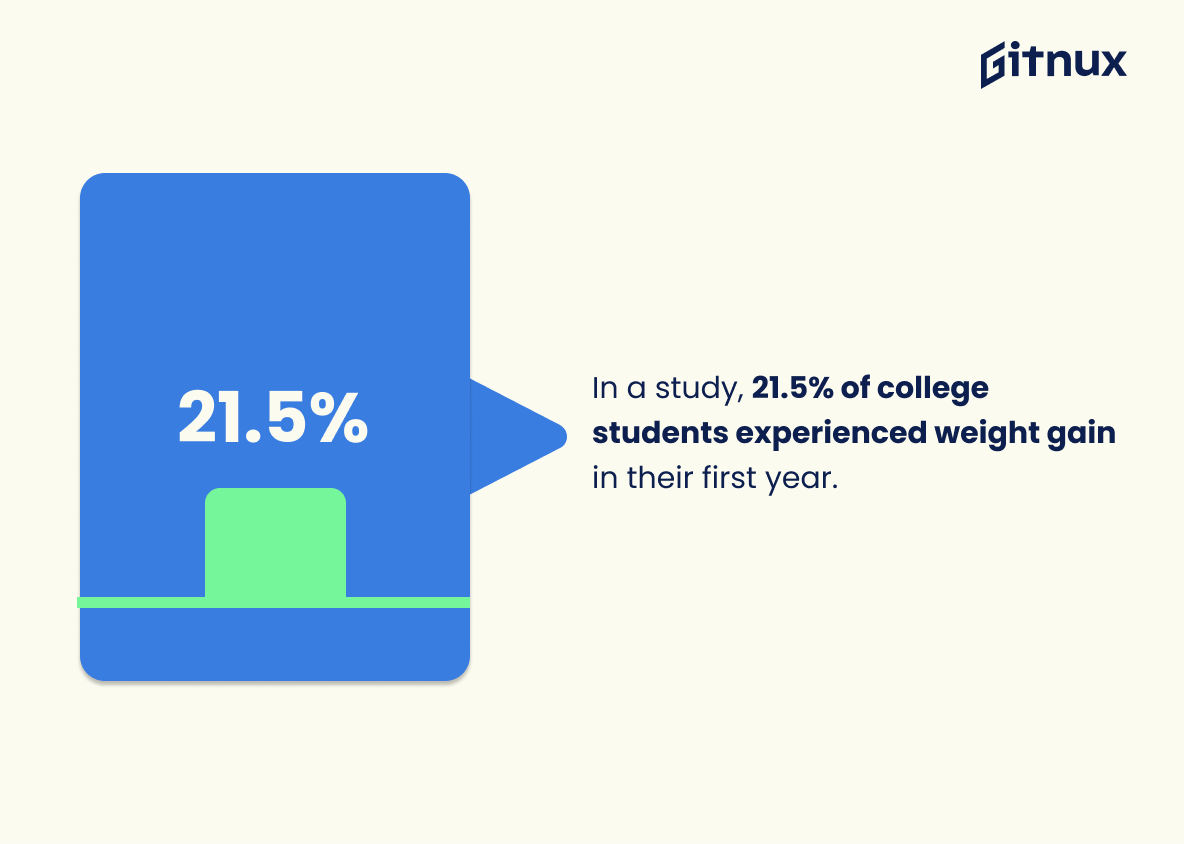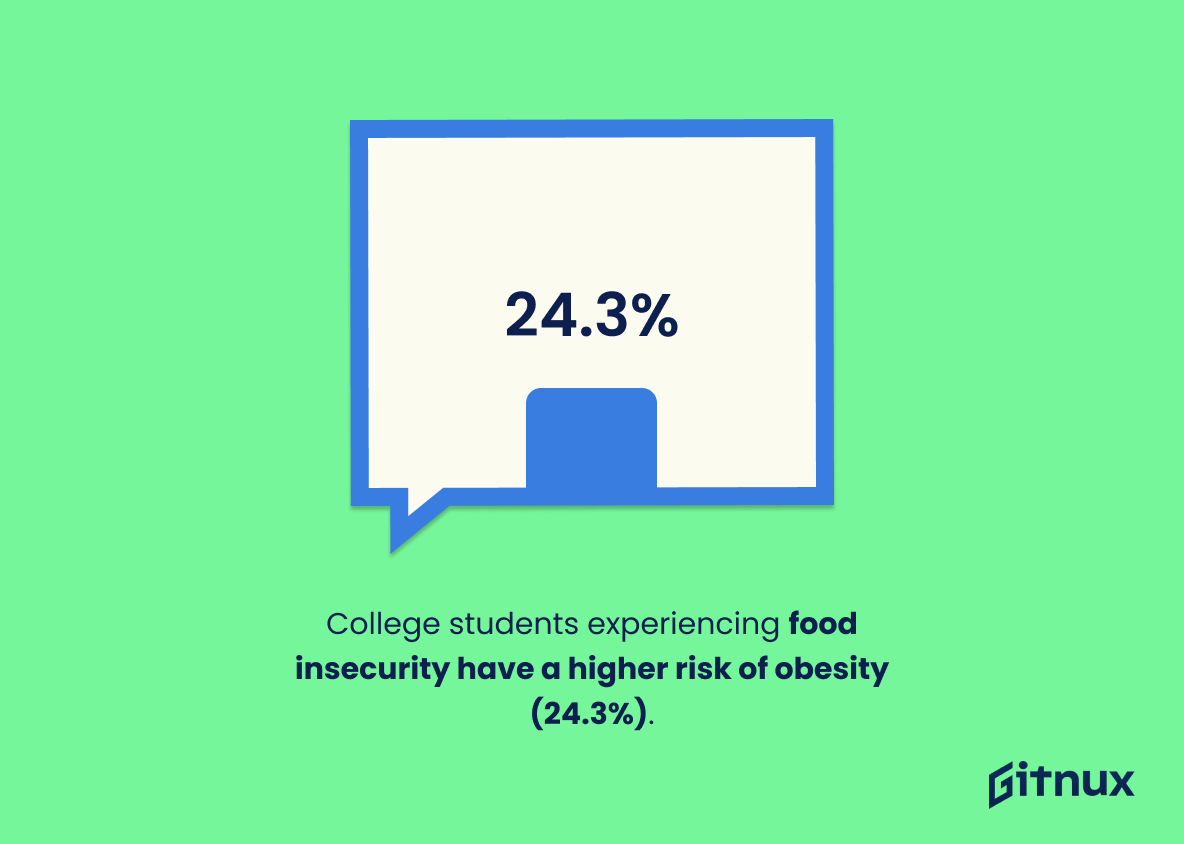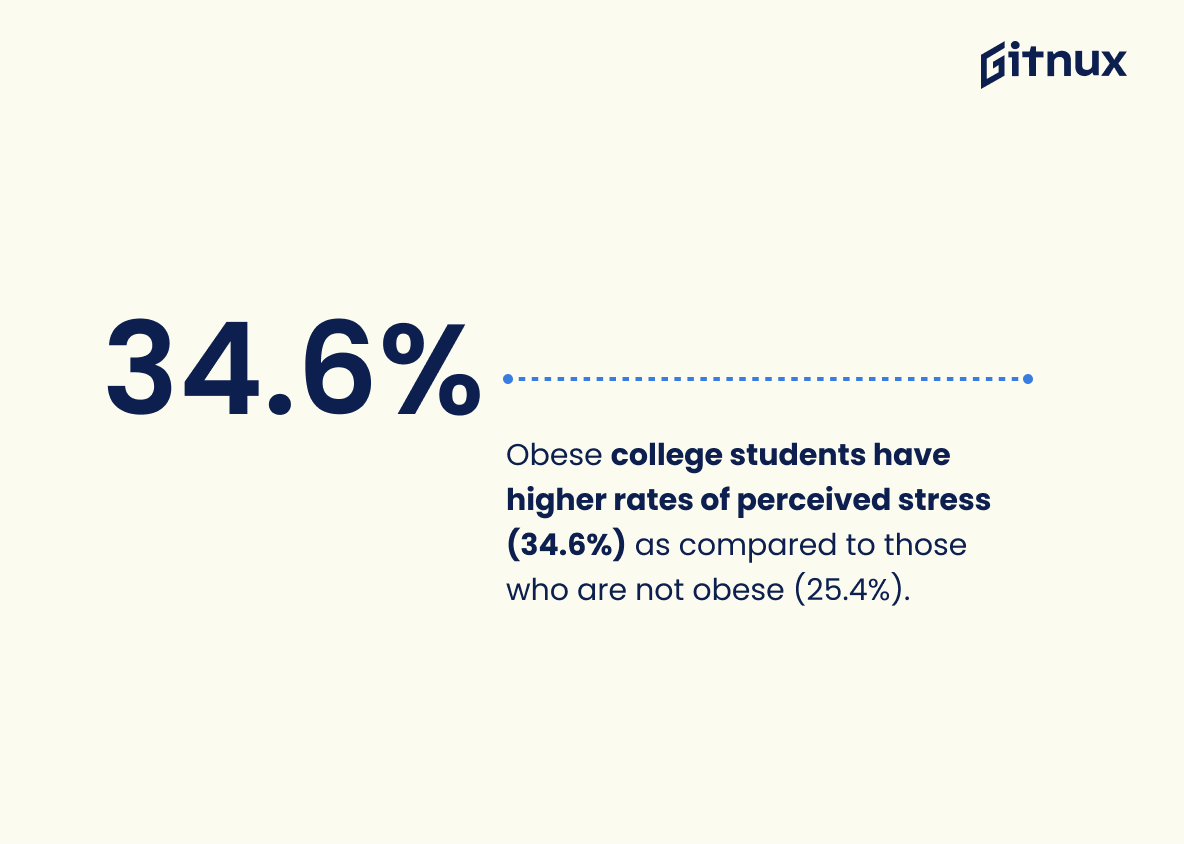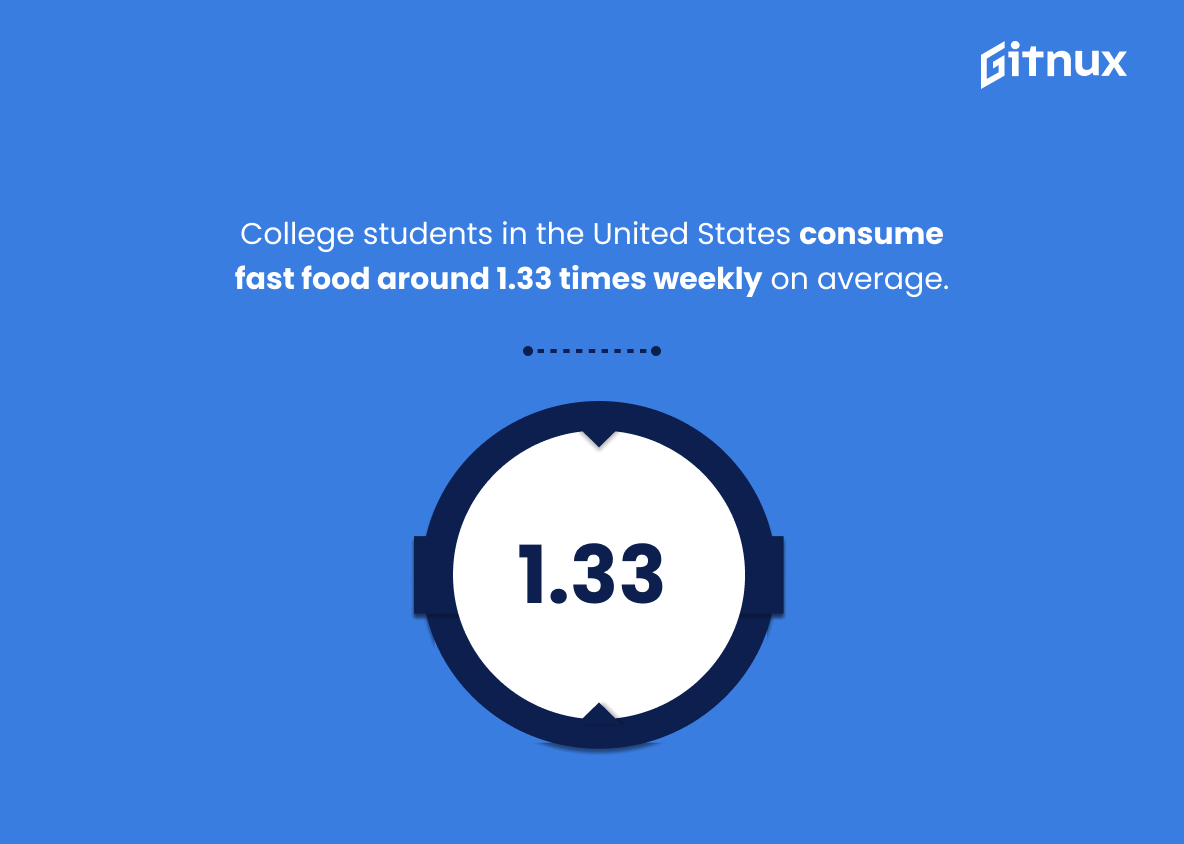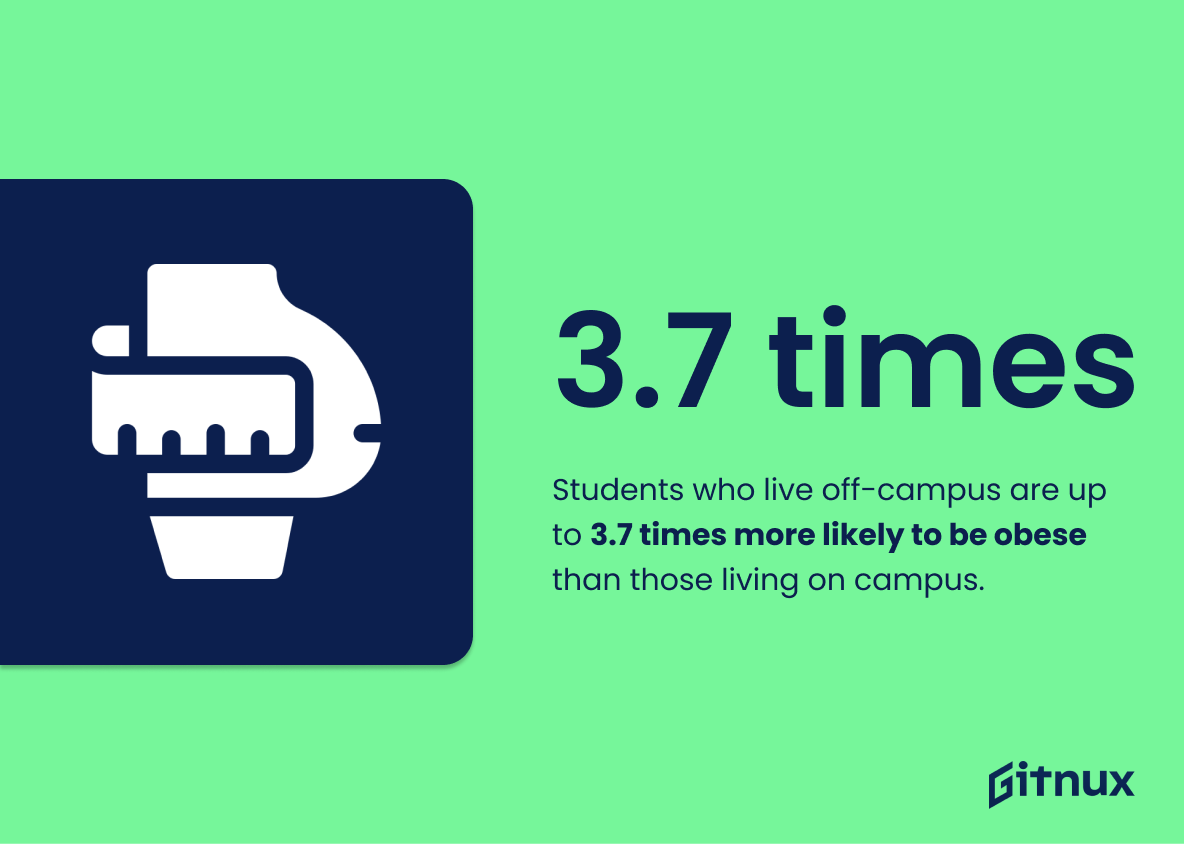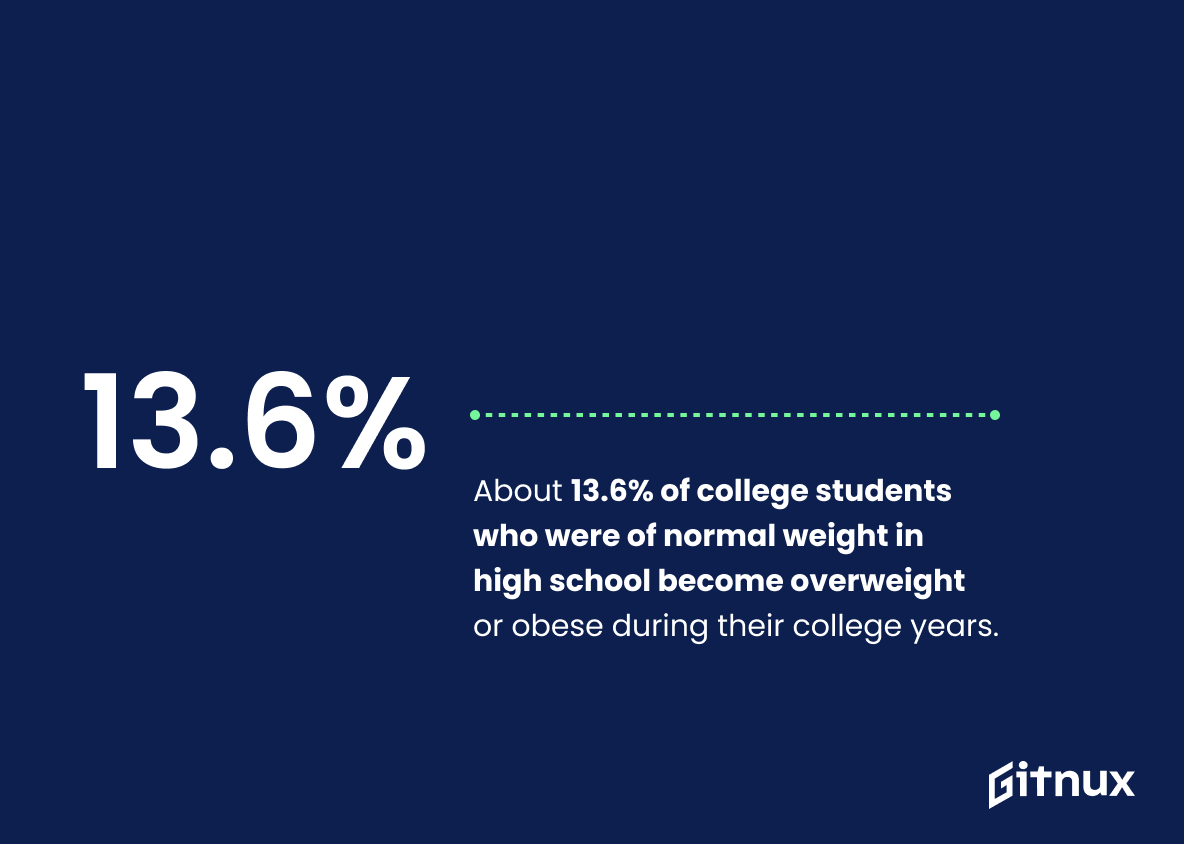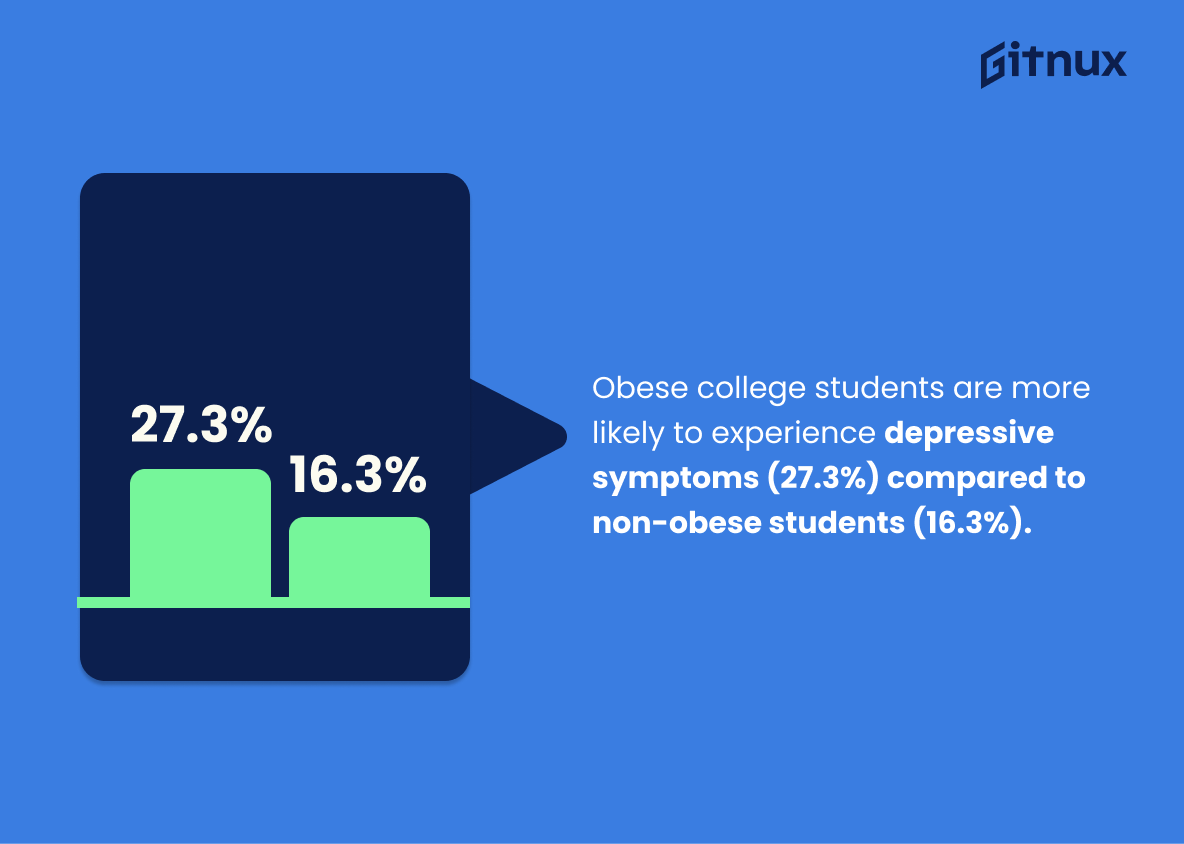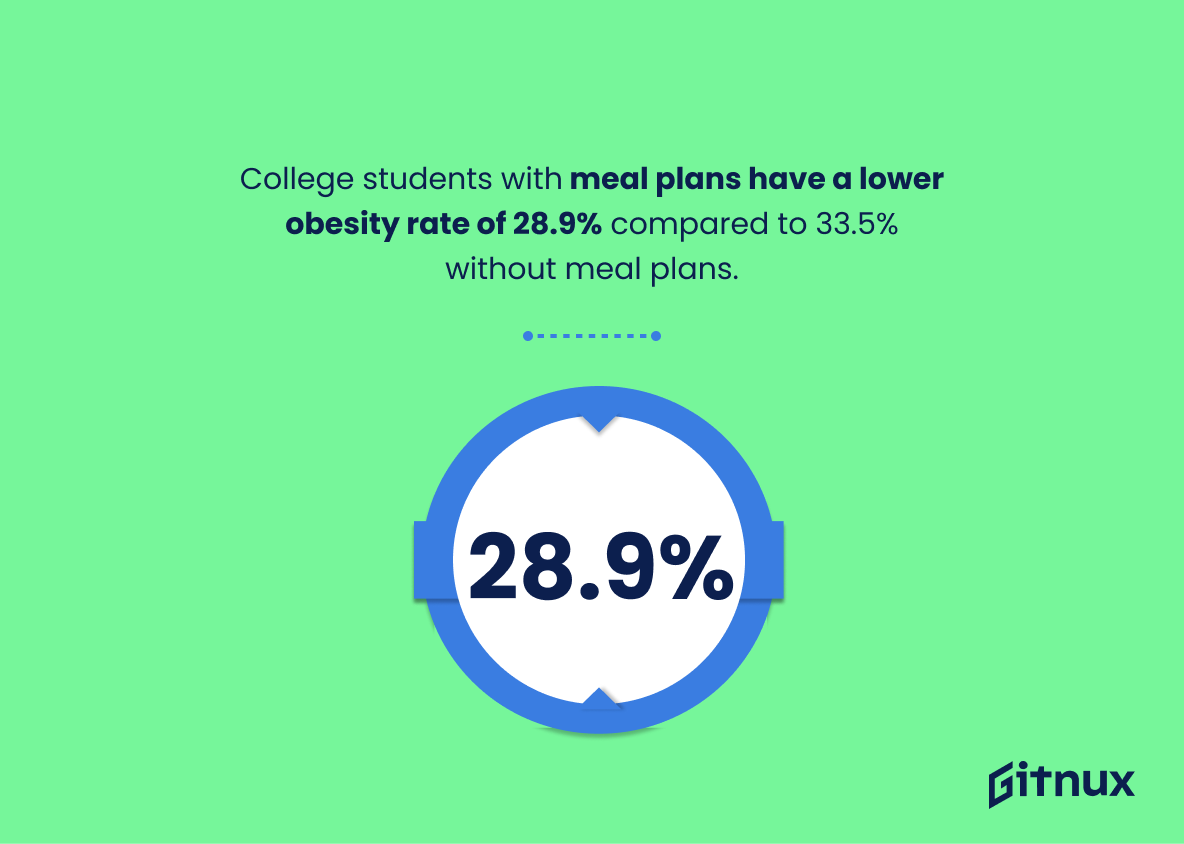The prevalence of obesity among college students in the United States is a growing concern. According to recent studies, approximately 20.9% of college students were classified as obese in 2018 and nearly 36.4% are overweight or have obesity. Additionally, 63% consume less than the recommended five servings of fruits and vegetables daily while 40.8% engage in at least 150 minutes of moderate-intensity aerobic activity per week.
Obese female college students displayed lower academic performance (GPA) compared to their peers, with 21.5% experiencing weight gain during their first year and 25%, gaining about 12 pounds on average over that same period due to binge drinking which contributes significantly to obesity rates amongst this population group – 47%. College student food insecurity has also been linked with higher risk for developing obesity (24%).
Furthermore, obese college students experience higher levels of perceived stress (34%) as well as poorer sleep quality (25%), when compared against non-obese counterparts; they are more likely not use meal plans resulting in an increased rate 33%; spend more time on computers for non-academic purposes increasing chances by 1/2; do not engage enough muscle strengthening activities twice weekly – 42%; and finally there is a difference between ethnic groups where Non Hispanic White Students had 13%, Non Hispanic Black Students 20 %and Hispanics 15%.
College Student Obesity Statistics Overview
About 63% of college students consume less than the recommended five servings of fruits and vegetables daily.
This statistic is a telling indicator of the potential health risks college students face. Eating fewer than the recommended five servings of fruits and vegetables daily can lead to a lack of essential vitamins and minerals, which can contribute to obesity and other health issues. This statistic serves as a reminder of the importance of maintaining a healthy diet, even in the midst of a busy college lifestyle.
40.8% of college students engage in at least 150 minutes of moderate-intensity aerobic activity per week.
This statistic is a beacon of hope in the fight against college student obesity. It shows that a significant portion of college students are taking the initiative to stay active and maintain a healthy lifestyle. This is an encouraging sign that college students are taking their health seriously and are actively working to prevent obesity.
Obese female college students displayed lower academic performance (GPA) as compared to their peers.
This statistic is a stark reminder of the impact that obesity can have on college students’ academic performance. It highlights the need for universities to provide resources and support to help students maintain a healthy weight and lifestyle, as this can have a direct effect on their academic success.
In a study, 21.5% of college students experienced weight gain in their first year.
This statistic is a stark reminder of the prevalence of weight gain among college students. It highlights the need for more education and resources to help students make healthier choices and maintain a healthy weight. It also serves as a warning to incoming college students to be mindful of their diet and exercise habits in order to avoid the same fate.
Over 25% of college freshmen gain about 12.2 pounds in their first academic year.
This statistic is a stark reminder of the potential for college freshmen to gain weight during their first year of college. It highlights the need for college students to be aware of the potential for weight gain and to take steps to prevent it. It also serves as a warning to parents and educators that college students may be at risk of gaining weight during their first year of college and that they should be aware of the potential for weight gain and take steps to prevent it.
About 47% of college students report binge drinking, which contributes to obesity.
This statistic is a stark reminder of the dangers of binge drinking among college students, and how it can lead to obesity. It highlights the need for more education and awareness about the risks of excessive drinking, and how it can contribute to weight gain. It also serves as a call to action for college administrators and health professionals to take steps to reduce binge drinking and its associated health risks.
College students experiencing food insecurity have a higher risk of obesity (24.3%).
This statistic is a stark reminder of the reality that college students facing food insecurity are more likely to suffer from obesity. It highlights the need for greater access to nutritious food options for college students, as well as the need for more education and awareness about healthy eating habits.
Obese college students have higher rates of perceived stress (34.6%) as compared to those who are not obese (25.4%).
This statistic is a stark reminder of the impact obesity can have on college students’ mental health. It highlights the fact that obesity can lead to higher levels of stress, which can have a detrimental effect on a student’s academic performance and overall wellbeing. It is a reminder that college students should be aware of the risks associated with obesity and take steps to maintain a healthy lifestyle.
Obese college students are more likely to experience poor sleep quality (24.8%) than their non-obese counterparts (17.7%).
This statistic is a stark reminder of the impact obesity can have on college students’ sleep quality. It highlights the importance of maintaining a healthy weight in order to ensure a good night’s rest. Poor sleep quality can have a detrimental effect on academic performance, mental health, and overall wellbeing, making this statistic an important factor to consider when discussing college student obesity.
College students in the United States consume fast food around 1.33 times weekly on average.
This statistic is a telling indicator of the prevalence of fast food consumption among college students in the United States. It speaks to the potential for unhealthy eating habits to contribute to the growing obesity epidemic among college students. It is a stark reminder that college students need to be mindful of their dietary choices and take steps to ensure they are eating a balanced diet.
Students who live off-campus are up to 3.7 times more likely to be obese than those living on campus.
This statistic is a stark reminder of the importance of living on campus for college students’ health. It highlights the fact that students who live off-campus are at a much higher risk of becoming obese than those living on campus, and this should be taken into consideration when discussing college student obesity statistics.
Among males, 46.3% of first-year college students believe that they need to lose weight compared to 53.5% of females.
This statistic is a telling indication of the gender disparity in college student attitudes towards weight. It suggests that males are less likely to feel the need to lose weight than females, which could be indicative of a larger issue of body image and self-esteem among college students. This could be a sign that more needs to be done to ensure that college students of all genders feel comfortable and confident in their own skin.
About 13.6% of college students who were of normal weight in high school become overweight or obese during their college years.
This statistic is a stark reminder of the potential for college students to gain weight during their college years. It highlights the importance of maintaining a healthy lifestyle during college, as the transition to college life can be a difficult one and can lead to unhealthy habits. It also serves as a warning to college students to be mindful of their diet and exercise habits, as the consequences of gaining weight can be serious.
Obese college students are more likely to experience depressive symptoms (27.3%) compared to non-obese students (16.3%).
This statistic is a stark reminder of the mental health implications of college student obesity. It highlights the fact that obese college students are more than 1.5 times more likely to experience depressive symptoms than their non-obese peers. This is an important issue to consider when discussing college student obesity, as it emphasizes the need for mental health support for those affected.
College students who use meal plans are less likely to become obese, with an obesity rate of 28.9% compared to 33.5% for those who don’t use meal plans.
This statistic is a powerful indicator of the importance of meal plans in helping college students maintain a healthy weight. It shows that students who use meal plans are significantly less likely to become obese than those who don’t, suggesting that meal plans can be an effective tool in combating obesity among college students.
About 42.3% of college students do not engage in muscle-strengthening activities at least twice per week, which may contribute to obesity.
This statistic is a stark reminder of the potential consequences of college students not engaging in muscle-strengthening activities at least twice per week. With nearly half of college students not engaging in such activities, it is no surprise that obesity is a growing issue among college students. This statistic serves as a call to action for college students to prioritize physical activity and make it a part of their weekly routine.
College students who spend more than 2 hours per day on a computer for non-academic purposes are 1.5 times more likely to be obese.
This statistic is a powerful indicator of the correlation between computer usage and obesity in college students. It highlights the importance of monitoring and limiting the amount of time spent on a computer for non-academic purposes, as it could be a contributing factor to obesity. This statistic is an important piece of information to consider when discussing college student obesity statistics, as it provides insight into the potential causes of the issue.
Among U.S. college students, the prevalence of obesity is 13% for non-Hispanic White students, 20% for non-Hispanic Black students, and 15% for Hispanic students.
This statistic is a stark reminder of the disparities in obesity prevalence among college students in the United States. It highlights the fact that non-Hispanic Black students are disproportionately affected by obesity, with a prevalence rate that is significantly higher than that of non-Hispanic White and Hispanic students. This data serves as a call to action for college administrators, health professionals, and policy makers to address the underlying causes of this disparity and to develop strategies to reduce obesity among college students.
Conclusion
The statistics presented in this blog post demonstrate that obesity is a serious issue among college students. Approximately 20.9% of college students were classified as obese in 2018, and nearly 36.4% are overweight or have obesity. Additionally, 63% consume less than the recommended five servings of fruits and vegetables daily, 40.8% engage in at least 150 minutes of moderate-intensity aerobic activity per week, 21.5% experience weight gain during their first year on campus, 25% gain about 12 pounds over the course of one academic year, 47 % report binge drinking which contributes to obesity risk factors such as food insecurity (24%), perceived stress (34%) poor sleep quality (25%), fast food consumption 1-2 times weekly on average(13%), living off campus 3x more likely to be obese than those living on campus(14), 46/53 male/female believe they need to lose weight respectively(15), 13 percent become overweight or obese from freshman year onwards(16) , 28 vs 33 for meal plan users & nonusers respectively with regards to being obese.(17). Furthermore 42 percent do not engage muscle strengthening activities twice a week contributing towards higher rates of Obesity.(18) Spending 2 hours plus per day using computers for nonacademic purposes increases chances by 50%. Lastly Non Hispanic White Students had an prevalence rate 13%, Black 20%, Hispanics 15%. It is clear that there are many factors associated with increased levels of student obesity; however it can be prevented through healthy lifestyle choices including regular physical activity and eating nutritious foods regularly throughout the school term
References
0. – https://www.www.ncbi.nlm.nih.gov
1. – https://www.www.researchgate.net
2. – https://www.pubmed.ncbi.nlm.nih.gov
3. – https://www.journals.plos.org
4. – https://www.link.springer.com
5. – https://www.stacks.cdc.gov
6. – https://www.www.mdpi.com
7. – https://www.www.jhsph.edu

